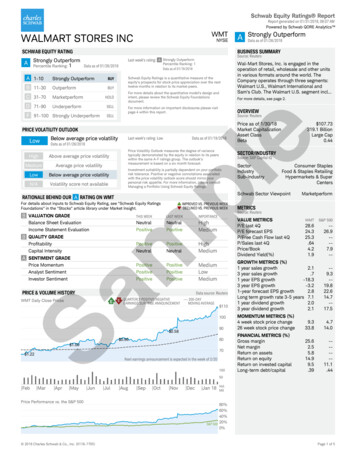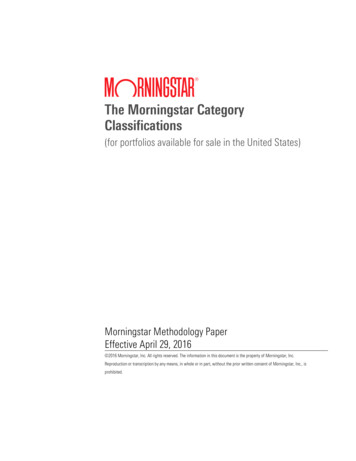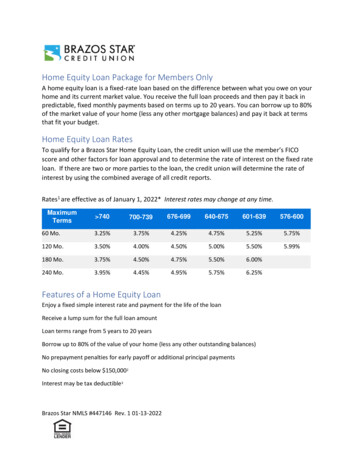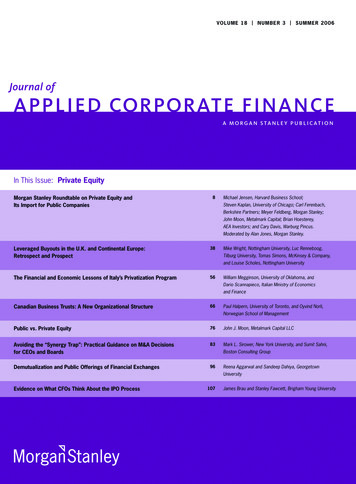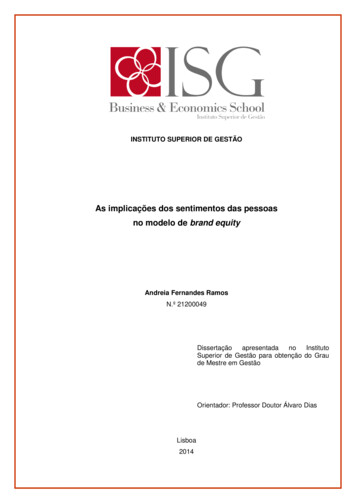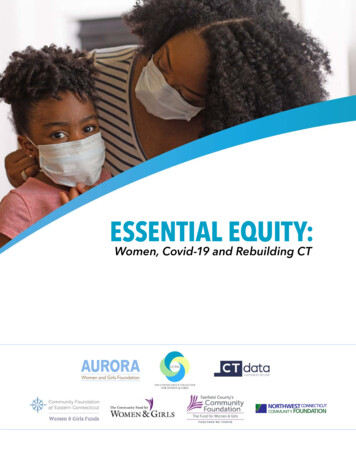
Transcription
ESSENTIALEQUITY:Women, Covid-19 and Rebuilding CT1
ABOUT THIS REPORTCovid-19 has revealed the inequities andinjustice that perpetuate the systems in ourstate and in our larger society. As advocatesfor women and girls, we knew that systemsof sexism and racism already disadvantagedwomen and girls and we braced ourselvesfor how the economic and health crisiswould further harm them. This reportdocuments the disproportionate impactof Covid-19 on women and girls, andparticularly on women and girls of color.We intend this vital information to inform decisions in the future that can direct resources to women and girls.We urge policymakers, government officials, philanthropists, nonprofit service providers, corporations and ourfellow community members to use this information to create equity through relief and recovery efforts.A COLLABORATIVE EFFORTThis report is a collaboration between funders and member organizations of the Connecticut Collective forWomen and Girls (CCWG) and the Connecticut Data Collaborative (CTData). The Connecticut Collective forWomen and Girls is a collaborative of organizations committed to the advancement of women and girls,including those who are cisgender, transgender, and non-binary, in the state of Connecticut. This report wasmade possible by generous funding from the: Aurora Women and Girls FoundationCommunity Fund for Women and Girls of theCommunity Foundation for Greater New HavenFund for Women & Girls of Fairfield County’sCommunity FoundationNorthwest CT Community Foundation in honor ofits Women & Girls FundWomen and Girls Funds of the CommunityFoundation of Eastern ConnecticutCTData’s work finding and analyzing data on raceand gender was led by Executive Director MichelleRiordan-Nold and staff members Elizabeth Grim andJason Cheung, who met the challenges of limiteddata sources and tight timeframes with outstandingresults.The Women and Girls DataPlatform is a cutting-edge onlinetool to share information andequip nonprofits, municipal andstate policymakers, corporationsand community members withdata for the advancementof women and girls. Visitwomenandgirls.ctdata.org tolearn more.Community partners contributing to this effortinclude the: Connecticut Women’s Education andLegal Fund (CWEALF), Sari A. Rosenbaum Fundfor Women and Girls of the Middlesex CountyCommunity Foundation (MCCF), Women and GirlsFund of the Mainstreet Community Foundation,Village for Children and Families, Health EquitySolutions, End Hunger Connecticut, Connecticut Coalition Against Domestic Violence, Connecticut FairHousing Center, and Connecticut Early Childhood Alliance.Thank you to our data partners for providing information for this report: United Way 211, ConnecticutFair Housing Center, Connecticut Department of Labor, Connecticut Department of Children and Families,
Connecticut Office of Early Childhood, Connecticut Department of Public Health, Connecticut Departmentof Social Services, Connecticut Coalition Against Domestic Violence, and Women’s Business DevelopmentCouncil.Special thanks to the Report Advisory Group who determined the focus areas, responded to drafts,connected with Community Partners for expert input, coordinated the roll out of the report to policymakersand the public:Chair Jenny Steadman (Aurora Women and Girls Foundation)Sharon Cappetta (Community Fund for Women and Girls of the Community Foundation for Greater NewHaven)Tricia Hyacinth (Fund for Women & Girls of Fairfield County’s Community Foundation)Julia Scharnberg (Northwest CT Community Foundation liaison to its Women & Girls Fund)Thayer Talbott (Sari A. Rosenbaum Fund for Women and Girls of Community Foundation of Middlesex County)Lauren Parda (Women and Girls Funds of the Community Foundation of Eastern Connecticut)Karla Fortunato (Connecticut Council for Philanthropy)Kara Straun (Community Fund for Women and Girls of the Community Foundation for Greater New Haven)Michelle Riordan-Nold (Connecticut Data Collaborative)Maddie Granato (Connecticut Women’s Education and Legal Fund)SOURCES AND TIME FRAME FOR THE REPORTAnalyses include publicly available administrative and survey data at the state level, disaggregated by sex,race, and ethnicity when available (see Resources). In addition, the Household Public Survey, a product of theU.S. Census Bureau in collaboration with five federal agencies, provided data on the social and economicimpacts of Covid-19 (See Appendix B for more details). Unless otherwise stated, data covers the time periodsof January 1 to September 30 for 2019 and 2020.TERMINOLOGYThroughout this report, we used the language for sex and gender in the way that it was collected by thedata source. For example, if the survey or administrative database used the language of female and male,we reported the terms as such rather than saying “women” and “men.” Too often, these data collection toolsconflated the constructs of sex and gender and limited response options to a binary.3
TABLE OF CONTENTSKey Findings. . . . . . . . . . . . . . . . . . . . . . . . . . . . . . . . . . . . . . . . . . . . . . . . . . . . . . . . . . . . . . . . . . . . . . . . . . . . . . . . . . . . . . 5Coronavirus: Exposing the Inequity in our Health Systems. . . . . . . . . . . . . . . . . . . . . . . . . . . . . . . . . . . . . . . . . . . . . . . 7Women as Essential Workers and Caregivers. . . . . . . . . . . . . . . . . . . . . . . . . . . . . . . . . . . . . . . . . . . . . . . . . . . . . . . . . . 9Child Care Crisis Threatens Economic Recovery . . . . . . . . . . . . . . . . . . . . . . . . . . . . . . . . . . . . . . . . . . . . . . . . . . . . . 13Eviction Crisis Threatens Women and Families. . . . . . . . . . . . . . . . . . . . . . . . . . . . . . . . . . . . . . . . . . . . . . . . . . . . . . . 16Mental Health Needs Increase for Women of Color. . . . . . . . . . . . . . . . . . . . . . . . . . . . . . . . . . . . . . . . . . . . . . . . . . . 18Home Unsafe for Women and Children. . . . . . . . . . . . . . . . . . . . . . . . . . . . . . . . . . . . . . . . . . . . . . . . . . . . . . . . . . . . . 20Hunger Hurts Women and Families . . . . . . . . . . . . . . . . . . . . . . . . . . . . . . . . . . . . . . . . . . . . . . . . . . . . . . . . . . . . . . . . 22Opportunities for Measuring Impact . . . . . . . . . . . . . . . . . . . . . . . . . . . . . . . . . . . . . . . . . . . . . . . . . . . . . . . . . . . . . . . 25References. . . . . . . . . . . . . . . . . . . . . . . . . . . . . . . . . . . . . . . . . . . . . . . . . . . . . . . . . . . . . . . . . . . . . . . . . . . . . . . . . . . . . . 27Appendix A: Demographics. . . . . . . . . . . . . . . . . . . . . . . . . . . . . . . . . . . . . . . . . . . . . . . . . . . . . . . . . . . . . . . . . . . . . . . 32Appendix B: Child Care . . . . . . . . . . . . . . . . . . . . . . . . . . . . . . . . . . . . . . . . . . . . . . . . . . . . . . . . . . . . . . . . . . . . . . . . . . 33Appendix C: Labor Force Participation. . . . . . . . . . . . . . . . . . . . . . . . . . . . . . . . . . . . . . . . . . . . . . . . . . . . . . . . . . . . . . 35Appendix D: Income & Employment . . . . . . . . . . . . . . . . . . . . . . . . . . . . . . . . . . . . . . . . . . . . . . . . . . . . . . . . . . . . . . . 36Appendix E: Initial Unemployment Claims . . . . . . . . . . . . . . . . . . . . . . . . . . . . . . . . . . . . . . . . . . . . . . . . . . . . . . . . . . 37Appendix F: Continued Unemployment Claims. . . . . . . . . . . . . . . . . . . . . . . . . . . . . . . . . . . . . . . . . . . . . . . . . . . . . . 39Appendix G: 211 Calls for Services. . . . . . . . . . . . . . . . . . . . . . . . . . . . . . . . . . . . . . . . . . . . . . . . . . . . . . . . . . . . . . . . . 41Appendix H: Housing . . . . . . . . . . . . . . . . . . . . . . . . . . . . . . . . . . . . . . . . . . . . . . . . . . . . . . . . . . . . . . . . . . . . . . . . . . . . 43Appendix I: Projected Increase in Homelessness. . . . . . . . . . . . . . . . . . . . . . . . . . . . . . . . . . . . . . . . . . . . . . . . . . . . . 44Appendix J: Mental Health. . . . . . . . . . . . . . . . . . . . . . . . . . . . . . . . . . . . . . . . . . . . . . . . . . . . . . . . . . . . . . . . . . . . . . . . 45Appendix K: Food Insecurity . . . . . . . . . . . . . . . . . . . . . . . . . . . . . . . . . . . . . . . . . . . . . . . . . . . . . . . . . . . . . . . . . . . . . . 474
KEY FINDINGSCovid-19 has exacerbated existing inequities,highlighting policy and system failures to supportConnecticut communities, especially women andwomen of color. These are not new challenges. Oursystems have been built on centuries of systemicracism, resulting in communities of color continuingto be under resourced. With women beingfoundational to both families and the Connecticuteconomy, questions include how can we: Prioritize gender and racial equity in COVID-19 relief and recovery efforts? Develop a state infrastructure that supports a productive modern workforce that recognizes the valuablecontribution of women?These are not rhetorical questions. Colleagues across the state and nation already know what works: investingin communities by investing in women. Data from the Supplemental Nutrition Assistance Program (SNAP)shows that providing additional income to families through unemployment benefits reduces the need for foodassistance.1 Housing advocates know that preventing evictions and foreclosures also prevents homelessness,which in turn reduces costs to the state through decreased demand on social services.UNEQUAL IMPACT ON WOMENThe current economic crisis has been termed the “shecession” because of its disparate impact on women.2Industries that have been impacted the most during the pandemic have been those with more femaleemployees such as healthcare, education, food service, and retail. It is also impacting industries that are largelywomen-owned businesses such as child care. Female caregivers are faced with choosing between remainingin the workforce and caring for children as child care is less available and schools close or move to alternativelearning models. Females have experienced more Covid-19 cases and deaths than males.3 Nationally, four times more females are leaving the workforce than males.4 Females have filed more unemployment claims and 75% of those claims were filed by females withouta college degree.5 Nearly 1 in 3 families have not been able to find quality child care during the pandemic.6 Housing insecurity has risen with increased evictions and mortgage delinquency.7,8 Food insecurity is expected to increase by 28% as a result of the pandemic.9 More females are reporting mental health concerns than males.10 Exposure to traumatic experiences, such as domestic violence, has increased.11 76% of parents who had to stay home and not work due to child care are female.12 The loss of income from women leaving the workforce just for one year could result in approximately 150-500 million in lost wages, if 1-3.5% of working mothers drop out of Connecticut’s labor force.13WOMEN OF COLOR EXPERIENCE GREATER IMPACT Overall, Black and Hispanic residents have had higher rates of Covid cases, deaths, and excess deathsthan white residents.14 Females of color account for over 1 in 3 initial (36%) and continued (43%) unemployment claims filed byfemales.15 Only 6% of families of color can afford high-quality infant or toddler programs.165
Homelessness is predicted to increase, which disproportionately impacts Black and Hispanichouseholds. More Hispanic females are reporting food insecurity, as compared to females of other races andethnicities.17 Hispanic females have reported consistently higher rates of mental health concerns than females ofother demographics.18OUR ECONOMY DEPENDS ON WOMENSince 2015, a primary driver of economic expansion has been women’s increased participation in theworkforce.19 However, most of the focus has been on diversifying staff and board representation rather thanbolstering systems that support women, particularly caregiving women, to enter the workforce and receiveadequate wages for their work. The Covid-19 pandemic has highlighted that women are the drivers of ourshared economy. 48% of the female labor force are essential workers, such as healthcare, child care, and service industryprofessionals.20 1 in 4 Connecticut businesses that applied for Federal PPP loans (and had gender identified on theapplication) were women-owned businesses.21 92% of private child care centers are women-owned.22AN EQUITABLE RECOVERY REQUIRES BOLD INVESTMENTS Significant investments in caregiving—from increased child care spots, subsidies to make care affordable,increased pay for child care and healthcare workers, to the ultimate goal of universal child care—arenecessary to support the full economic participation of a diverse, twenty-first century workforce. Significant investments in access to healthcare—from expanded HUSKY eligibility, continued fundingfor telehealth, to the acknowledgement of racism as a public health crisis—are necessary to support thehealth of all Connecticut residents. Significant investments in housing—from funding to assist with back rent, prevent evictions andhomelessness, and provide safe housing for domestic violence survivors—are necessary to provide basicneeds and the foundation for a sound economy. Significant investments in equitable pathways to high-wage, high-growth jobs and a commitmentto closing gender and racial wage gaps and preventing discrimination and harassment will createeconomic security for women and their families.76%of parents who had to stay home and not work due to childcare are female28%of Connecticut’s Covid-19 cases were Hispanic individuals,but Hispanic individuals only make up 16% of the state’spopulation48%of the female labor force are essential workers, such ashealthcare, child care, and service industry professionals6
CORONAVIRUS:EXPOSING THE INEQUITYIN OUR HEALTH SYSTEMSConnecticut’s communities have been devastated by the coronavirus (Covid-19) pandemic. As one of thestates impacted early in the pandemic, Connecticut saw record-breaking cases, hospitalizations, and deathsin spring 2020 and a flattening of the curve during the summer months. During fall 2020, Covid-19 testrates started to rise again with a 1.9% positivity rate as of September 30, 2020 and a 6% positivity rate as ofDecember 15, 2020.2354%of Covid-19 cases were females15%of Covid-19 deaths were Black individuals, while Blackindividuals make up only 10% of the state’s population41,920is the current income threshold for eligibility for the state’sHusky health insurance program for a family of four Females have experienced slightly more Covid-19 cases and deaths than males.23COVID-19 CASESCOVID-19 DEATHS57,742 Total Cases54%Females(18 cases per 1,000)4,511 Total Deaths46%Males(14 cases per 1,000)52%48%FemalesMales(1.3 deaths per 1,000) (1.2 deaths per 1,000)7
Covid-19 has disproportionately impacted Black and Brown communities in Connecticut with higher ratesof cases, deaths, excess deaths, and hospitalizations. Black individuals make up only 10% of the Connecticutpopulation, yet accounted for 18% of cases and 15% of deaths. Hispanic individuals make up 16% of theConnecticut population and experienced a similarly disproportionate impact in cases (28%) but accounted for9% of deaths.Black and Latino residents are more likely to have had a close friend or family member whotested positive for Covid-19, was hospitalized, or died from Covid-19, than white residents.25Black42%Latino26%46%White23%30%Know someonewho TESTEDPOSITIVE20%15%16%Know someonewho WASHOSPITALIZED12%Know someonewho DIEDExcess deaths are deaths that occurred above and beyond what would be expected in an average year.Females who identified their race or ethnicity as Other, Black, and Hispanic were most impacted by thepandemic, reporting excess deaths of 131%, 79%, and 69%, respectively. While there is no certainty thatexcess deaths are directly or indirectly due to Covid-19, excess deaths are consistent with trends in the overallCovid-19 death data provided by the Connecticut Department of Public Health (CT DPH).RECOMMENDATIONSIn partnership with Health Equity Solutions and the Village for Children and FamiliesImmediate relief Restore the HUSKY A eligibility limit for parents to 201% of the federal poverty level. Extend and expand access to telehealth to create access to mental and physical health services forwomen and girls. Telehealth must be reimbursed on par with in-person visits.Long-term recovery Acknowledge, at all levels of government, that racism is a public health crisis.DATA LIMITATIONS At this time, CT DPH does not provide Covid-19 data disaggregated at the intersection of sex/genderand race/ethnicity or by sex/gender and age. Excess deaths data has a lag time in reporting given that Connecticut is one of the few states thatstill operates with a paper rather than electronic death record system. They also do not provide datadisaggregated by age and gender together8
WOMEN AS ESSENTIALWORKERS AND CAREGIVERSThe disparate impact on women could have profound economic implications both in the short and long term.Since 2015, a primary driver of economic expansion has been women joining the workforce. Unlike the 2008recession, the sectors of the economy affected the most during Covid-19 are those in which the workforce ispredominantly female, such as hospitality, child care, retail, and healthcare. The current economic recessionhas been deemed a “shecession” because of this greater burden on women. See Appendix A for pre-Coviddata on the social and economic status of women.75%of initial and continuing unemployment claims weremade by females without a college degree70%of females who identify their race or ethnicity as Otherexperienced a loss of income since March49%of Connecticut’s labor force is female.Women make up 49% of Connecticut’s labor force with approximately 940,750 females in the labor force.26Certain industries are more female-dominated with females making up 78% of the healthcare workforce, 67%of the education workforce, and 56% of accommodation and food service industries. Together these industriesaccount for almost half (48%) of the state’s female labor force.27 These three industries are also among thosemost heavily impacted during the Covid-19 pandemic, suggesting increased economic impact for women.9
Women are increasingly experiencing social, economic, andfamilial burdens forcing them to choose between enteringor remaining in the workforce versus caring for childrenand/or adult relatives at home. Women are more likely toassume caregiving responsibilities for children and otherfamily members. Over 2 in 3 caregivers are female and, whileevery family is different, on average females may spend upto 50% more time caregiving than males.28, 29 Combine thiswith closing child care centers, schools shifting to remote andhybrid models, adult children moving home from collegewhile campuses are closed, and some families opting tomove older adults home from assisted living facilities, and wehave a crisis.FEMALES MAKE UP:78%of the healthcareworkforce67%of the educationworkforce56%of the food serviceindustyNationally, in April during the peak of the first Covid-19wave, mothers reduced their participation in the labor forceTogether these industries accountby 2.7 to 4.3%, depending on the age of their child(ren).30Additionally, “Four times as many women as men droppedfor almost half (48%) of the state’sout of the labor force in September, roughly 865,000 womenfemale labor force.compared with 216,000 men.”31 While no causal evidenceexists, this time frame coincides with the start of the school year and may be associated with challenges relatedto navigating the workplace with child care closures and remote or hybrid education models, contributing towomen dropping out of the labor force.Of Connecticut parents who reported having to stay home and not work due to child care in fall 2020,76% were female versus 24% male (see Appendix B).32 In Connecticut, 271,000 employed mothers (29%)have children under the age of 18.33 If even just 1-3% of these mothers leave the labor force, Connecticutcould see a loss of between 150 and 500 million in annual wages for one year alone (see Appendix C forcalculations).34 These numbers are likely low estimates of the economic impact to Connecticut since they donot account for lost income tax or a reduction in sales tax revenue due to lower consumption by households.Furthermore, “women who exit the labor force to provide care often have difficulty reentering employment ata later date—an experience likely to be exacerbated in an economy with high unemployment rates. In addition,extended time out of work has significant negative effects on future earnings potential and can underminefuture retirement security. Previous CAP research found that a 26-year-old working woman earning the medianwage who took five years off to provide care would reduce her lifetime earnings by 19 percent. This includesnot just lost wages over that time period but also lost wage growth andlost retirement assets.”35NEARLY HALF OF CT WOMEN LOST INCOME36 47% of Connecticut residents had a Covid-19 related lossof income near the beginning of the pandemic, with thatpercentage only decreasing slightly to 45% by the end ofSeptember 2020 (see Appendix D). More females of color have experienced loss of income thanwhite females. In particular, females who identified their race orethnicity as Black, Hispanic, or Other were more likely to reporthaving experienced a loss of income.10OF CONNECTICUT PARENTS WHOREPORTED HAVING TO STAY HOMEAND NOT WORK DUE TO CHILDCARE IN FALL 2020, 76% WEREFEMALE VERSUS 24% MALE
WOMEN’S UNEMPLOYMENT CLAIMS REACH CRISIS LEVEL37, 38 After 52% of initial unemployment claims and 56% of continuing unemployment claims have been filedby females, indicating long term unemployment. (see Appendices E & F) 75% of initial and continuing unemployment claims were made by females without a college degree (ofthose reporting their education level). More than 1 in 3 (36%) of initial claims filed by femaleswere by females of color: 18% Hispanic or Latino, 13%Black or African American, 5% Asian or Other PacificIslander, and less than 1% identify as Native American. 43% of continued claims filed by females were by femalesof color: 21% Hispanic or Latino, 17% Blackor African American, 4% Asian or Pacific Islander, less than1% identify as Native American. Hispanic and Black females are overrepresented incontinued claims, as compared to race and ethnicitydistribution for the female population in the labor force(13% Black or African American; 16% Hispanic).39FAMILIES STRUGGLE WITH BASIC EXPENSES 34,112 income and employment-related calls were madeto Connecticut 211 in the first 9 months of 2020, marking a27% increase from 2019 (see Appendix G). Of the employment and income-related 211 calls withavailable gender data, 69% were female and 31% weremale.40 Slightly more females than males (14% vs 12%) reportedthat paying for their usual expenses was very difficult.41OVER 50%of initial unemploymentclaims have been filedby females3 OUT OF 4Females applying forinitial and continuingunemployment did nothave a college degreeOVER 1 IN 3of initial claims filedby females were byfemales of color Asian and white females have struggled the least, whileBlack and Hispanic females have struggled the most—1 in 5Black and Hispanic females said it was very difficult to meet their usual expenses.42WOMEN-OWNED BUSINESSES AT RISK OF FAILUREIn addition to women workers being disproportionately impacted by the Covid-19 pandemic, so haveConnecticut’s women-owned businesses. Industries which attract a majority female workforce are also morelikely to have higher percentages of women-owned businesses.Across all industries, healthcare and social assistance (72%), educational services (66%), and retail trade (57%)have the highest percentages of women-owned businesses, according to the CT Secretary of State’s businessregistration data.43 These industries were also among those most impacted by the pandemic.The Federal PPP loan program administered approximately 65,000 loans to businesses in Connecticut as ofAugust 2020. Gender was identified on only 19% of the applications. Of those where gender was identified,approximately 1 in 4 (or about 2,800) were women-owned businesses. The top industries that received PPPloans for women-owned businesses included: beauty salons (5%; 144 businesses), full-service restaurants (5%;132 businesses), limited service restaurants (3%; 92 businesses), child day care services (3%; 90 businesses),and offices of real estate agents and brokers (3%; 87 businesses).4411
RECOMMENDATIONSIn partnership with Connecticut Women’s Education and Legal Fund (CWEALF)Immediate relief Provide financial support for women and minority owned businesses. Ensure all Connecticut workers, regardless of employer size or occupation, have access to workplacesupports during the pandemic, including paid sick leave. Increase financial support to workers through unemployment insurance benefits and provide financialsupport for workers who are ineligible for federal relief programs.Long-term recovery Fully implement Connecticut’s landmark paid family and medical leave program. Continue increases in the state’s minimum wage to reach 15/hour by 2023 and consider increasing payfor all essential workers immediately. Advance policies that aim to close gender and racial wage gaps for women and prohibit discriminationthat prevents women, specifically women of color, from advancing in the workforce. This includessupport for equitable pathways to high-wage, high-growth jobs and legislation that requires employersto provide salary ranges for vacant positions and pay their employees equal pay for comparablework; prohibits discrimination based on hair style, texture, or type (the CROWN Act); and strengthensConnecticut’s stance against harassment in the workplace.DATA LIMITATIONS Most income and employment data sources, with the exception of CT DOL data, limited gender to bebinary. Race and ethnicity categories did not fully encompass the diversity among Connecticut communitieswith many of our people forced to choose the “Other” category, thereby literally othering theseindividuals. CT SOTS only began asking about women and minority owned businesses in 2020. Only 19% of the applications for Federal PPP loans identified gender .12
CHILD CARE CRISIS THREATENSECONOMIC RECOVERYAccess to affordable quality child care is essential for supporting Connecticut’s workforce. The Covid-19pandemic has threatened the collapse of the entire child care industry. Providers have faced impossiblechoices to remain open despite declining enrollment and changing public health guidelines. With caregiverstrying to balance child care and work, families are struggling to find affordable quality child care now morethan ever.46,349child care slots are expected to be lost due to the pandemic94%of families of color can’t afford high quality child care92%of private child care providers are women-owned businessesConnecticut is home to 184,983 children under the age of 5 years,which is the age group most in need of child care services.45 Accordingto the Center for American Progress, the Covid-19 pandemic couldresult in the loss of almost half (48%) of Connecticut’s child care supply,accounting for 46,349 licensed slots.46 The state is already well onits way to meet this benchmark with Connecticut’s child care centerscurrently operating at 30% less capacity than before Covid-19.47In addition, prior to Covid-19, 44% of Connecticut residents lived in achild care desert. “A child care desert is any census tract with more than50 children under age 5 that contains either no child care providers or13THE COVID-19 PANDEMIC COULDRESULT IN THE LOSS OF ALMOSTHALF (48%) OF CONNECTICUT’SCHILD CARE SUPPLY, ACCOUNTINGFOR 46,349 LICENSED SLOTS.
so few options that there are more than three times asmany children as licensed child care slots.”48At the same time that child care centers are closing,demand for child care is also changing. The ConnecticutOffice of Early Childhood (CT OEC) estimates that2.3 children4.41 childrenConnecticut needs at least twice as much child careper availableper availablenow compared to pre-Covid due to remote and hybridchild care slotchild care slotlearning models that are keeping children at home with49prior toafter Covid-19working caregivers. This raises concerns given thatConnecticut already had a competitive child care marketCovid-19that was unable to meet the need. Prior to Covid-19there were about 2.30 children per available child careslot. This is estimated to nearly double to 4.41 children per child care slot after Covid-19.50With increased demand for child care, families are struggling to find care for their children. According to aCT OEC parent survey, nearly half (45%) of families kept children home from child care due to Covid-relatedhealth concerns and about 1 in 3 (35%) were unable to find child care when needed.51 These findings areconsistent with the 2020 Connecticut Wellbeing Survey, which found that 40% of adults living with childrenhave “found it more difficult than usual to handle child care.” The impacts are disproportionately impactingwomen with 47% of all women respondents expressing this concern and 59% of women who are working fulltime, compared to 34% and 37% of men respectively.52Access to child care is also marked by racial disparities, withchild care deserts more likely to be in geographic areas withhigher percentages of rural families, Black/African American andHispanic/Latino families, and low-income families. In Connecticut,8 in 10 families cannot afford the full cost of high quality infantand tod
Housing Center, and Connecticut Early Childhood Alliance. Thank you to our data partners for providing information for this report: United Way 211, Connecticut Fair Housing Center, Connecticut Department of Labor, Connecticut Department of Children and Families, The Women and Girls Data Platform is a cutting-edge online tool to share .


